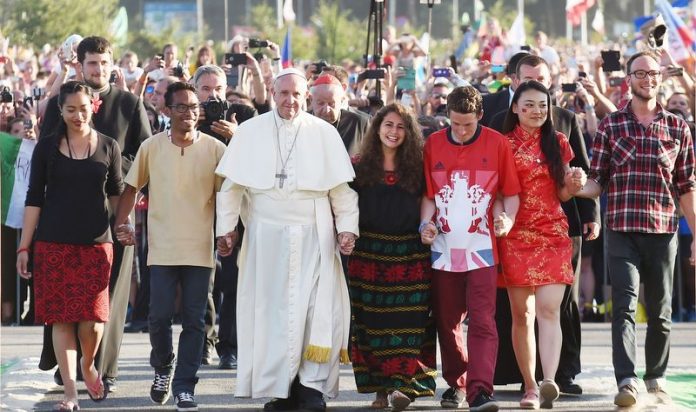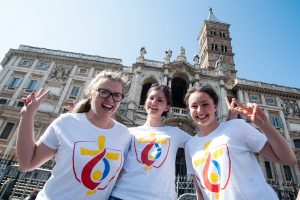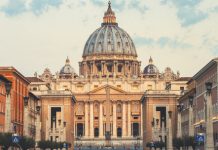
A look at the Synod on Young People, the Faith, and Vocational Discernment
KATIE PREJEAN McGRADY
I was in the midst of changing my four-month-old daughter’s diaper when I first received word that I’d been selected by the USCCB to attend the pre-synod gathering of young adults in Rome. My bishop called me early one morning, informing me that he’d given his blessing and seal of approval for me to be sent, and I should expect a call soon.
As I waited, I asked myself, “Why do I need to go? And what even is a pre-synod? And how could I possibly be necessary to anything that happens at the Vatican? They should pick someone else.”
A few hours later, I learned both what my task was and why I’d been chosen: I was being sent to Rome as one of three representatives to work on behalf of the youth and young adults of the U.S. at a first-of-its-kind gathering to prepare for the Ordinary Synod in October 2018, that would focus on “Young People, the Faith, and Vocational Discernment.” I was being sent because of my experiences as an educator, writer, and speaker, but also because of my vocation as a wife and mother and my personal faith. Paul Jarzembowski, the USCCB staffer that called me, said, “It’s with great joy that we send you, Katie, because we feel you have a lot to offer.”
Would that all young people hear those words regularly: We feel you have a lot to offer.
The presence of young people
 The Synod on “Young People, the Faith, and Vocational Discernment” was monumentally significant because of its main areas of focus: how to reach and walk with disaffiliated teens and young adults who have left the Church, to discern what young people need from the Church today, and to answer how best to articulate why this is the Church meant for them and why our teachings are life-giving and true and necessary in a world filled with lies. The Synod concentrated on answering these big questions — most significantly how we can help teens and young adults encounter Jesus Christ and use their gifts in the life of the Church. This wasn’t some small gathering to make the Church “look good” to youth. This was a gathering meant to signal to all of us just how important the Church considers young people to be.
The Synod on “Young People, the Faith, and Vocational Discernment” was monumentally significant because of its main areas of focus: how to reach and walk with disaffiliated teens and young adults who have left the Church, to discern what young people need from the Church today, and to answer how best to articulate why this is the Church meant for them and why our teachings are life-giving and true and necessary in a world filled with lies. The Synod concentrated on answering these big questions — most significantly how we can help teens and young adults encounter Jesus Christ and use their gifts in the life of the Church. This wasn’t some small gathering to make the Church “look good” to youth. This was a gathering meant to signal to all of us just how important the Church considers young people to be.
At the root of all the conversations — as seen in the interventions and press conferences and reflected in the final document — was a fairly simple theme: What does the Church have to offer the young people of the world, and what do young people have to offer the Church? Over the course of both the pre-Synod gathering and the Synod itself, something became very clear: The answer to both those questions is, very simply, “a lot.” The Church has a lot to offer young people, and young people have a lot to offer the Church.
On the first day of the pre-Synod in March, the first time the Church has intentionally gathered young people together and spent time listening to their thoughts in a formal and official way, Pope Francis came to spend time with us, answering our questions and sharing his heart. With his signature simplicity and pastoral kindness, he spent four hours with us. That’s no short amount of time, especially for the Holy Father, whose schedule is full and whose time is precious. And yet he spent an entire morning with a group of young adults, signaling to the whole Church that any time spent dialoguing with young people is time well spent. It was evident that we mattered to him, that he was happy to be with us, and that he looked forward to hearing our thoughts and ideas.
In his time with us, as he encouraged us to be honest and open throughout the week of conversation and work, he asked us to be unafraid to speak our minds, share our hearts, and boldly articulate what we need from the Church. He said something simple, yet profound: “If you are not present, then a part of the access to God is missing!” As soon as he said those words, I heard the words of Paul from the USCCB again: “We feel you have a lot to offer.”
This Synod on young people was a declaration by the Church that young people have a lot to offer and that if they are not present — and if we don’t accompany them, listen to them, and teach them well — then a part of the access to God is missing. The final document of the Synod reflected this message: “With [young people] we can more prophetically read our age and recognize the signs of the times; this is why young people are one of the ‘theological places’ in which the Lord makes us know some of his expectations and challenges to build tomorrow” (Final Document, 64). In short: Young people are an access point to God — a way to approach the Lord — and to ignore them, write them off as useless or as simply “a problem to be solved,” and not bring forth and foster their gifts and talents, is to write off the Lord himself.
In a world running rampant with relativism, consumerism, and lies about what makes a person valuable and necessary, the Church teaching the truth boldly to young people must be a priority. In a world that tells youth and young adults to simply do whatever makes them feel good as long as it doesn’t really hurt anyone else, the Church must be present to unabashedly proclaim right from wrong and truth from lies. At a time when young people are often seen as a burden on society with their entitled attitudes and addiction to screens, the Church must be a home to them, welcoming them with their thoughts and ideas, gifts and talents.
This Synod on young people came at precisely the right moment to analyze the challenges young people face, articulate the work the Church must do, and listen to young people themselves about what they need and want from the Church and where they are confused and need answers as they journey through life.
A few key things show just how important this gathering was, the first of which is recognizing who was invited to participate. By holding the pre-Synod in March with 300 young adults, and then by inviting a few dozen young adult auditors to participate in the Synod in October, this Synod clearly was not just about young people, but was for, with, and of young people. The bishops of the world gathered for a meeting that had all the formalities and structure of previous synods: bishops in a hall, giving short speeches, engaging in small group discussions, and offering addendums and notes to the final document. But with young adults present for the proceedings of the Synod, having been listened to in March at the pre-Synod meeting and heard in the thousands of survey answers given for months before that, this Synod felt very different. This modeled a very important element of ministry to youth and young adults: making space at the table for young people to speak, share, be present, and offer their gifts.
By having young people involved, the Church indicated that this wasn’t just “business as usual.” Rather this was forging a new model of how parish and diocesan youth and young adult ministry can look — allowing young people to become protagonists in their journey of faith, not merely dragged along or told what to believe, but engaged and dialogued with, able to contribute as they are formed, to offer their gifts as they are accompanied, and to ask questions as they learn.
The Road to Emmaus story from the Gospel models of this style of ministry and the final document of the Synod is based around this familiar story. Part 1 of the final document, titled “He walked with them,” unpacks a Church that listens, asks good questions, recognizes the challenges and difficulties young people face today, and is unafraid to embrace youth even in their struggles. Part 2, entitled “Their eyes are opened,” explores how youth and young adulthood is a chance to not only discern and explore, but also a time to be open to the movement of the Spirit during the transition from high school to college, college to the workforce, and single life to married life, and to discern the various ways the Lord works in one’s life. Part 3, entitled “They left without delay,” provides a model of accompaniment, of walking alongside young people, allowing the voices of many to come together to form one unified voice and vision.
A worthy task
One key moment illustrated the true necessary of this Synod. One afternoon, before the evening session began, Pope Francis climbed the steps of the Synod hall to greet the young adult auditors and press pool standing in the back. As he spoke with them, shaking hands and asking questions, he encouraged them to keep making noise — to continue speaking up in small groups, clapping during interventions they liked, and engaging with the bishops and sharing their thoughts. The Vicar of Christ himself wanted young adults to know the value of their presence and what they had to offer. He wanted to help open their eyes and inspire them to share that with others, without delay.
As crisis and scandal embroils the Church, when the very “idea” of religion seems one of a myriad of other “life options,” and when there seems to be a steep decline in decision-making based on morals, a Synod addressing how to minister to, walk with, teach, and love young people could not have come at a better time. Moreover, a Synod that sought to address those issues with young people themselves indicates that for youth and young adult ministry to truly work, we cannot merely spout platitudes, run basic programs, and answer questions with “because we said so.”
Ministry to young people needs to be ministry with young people, and that accompanying them on their journey is a worthwhile task and a chance for the Church to grow. Because the Church has a lot to offer young people … and young people certainly have a lot to offer the Church.
Katie Prejean McGrady is an international speaker, podcaster, and author of Room 24: Adventures of a New Evangelist and Follow: Your Lifelong Adventure with Jesus. She taught freshman theology and ran a parish youth ministry program for six years. Katie was one of three representatives chosen by the USCCB to attend the Vatican’s Pre-Synod gathering in March 2018. Visit KatiePrejean.com.
This article was originally published in Catechist magazine, February 2019
Photos: Top, Ciric International; Christophe Testi, Creative Shot Photography




